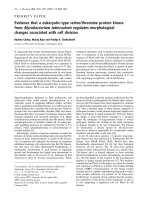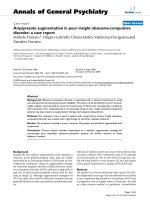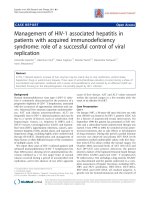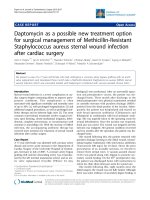Báo cáo y học: "Management dilemma; a woman with cystic fibrosis and severe lung disease presenting with colonic carcinoma: a case report" pdf
Bạn đang xem bản rút gọn của tài liệu. Xem và tải ngay bản đầy đủ của tài liệu tại đây (154.78 KB, 3 trang )
BioMed Central
Page 1 of 3
(page number not for citation purposes)
Journal of Medical Case Reports
Open Access
Case report
Management dilemma; a woman with cystic fibrosis and severe lung
disease presenting with colonic carcinoma: a case report
Andrea N Lees and David W Reid*
Address: Department of Respiratory Medicine, Royal Hobart Hospital, 48 Liverpool Street, Hobart, Tasmania 7000, Australia
Email: Andrea N Lees - ; David W Reid* -
* Corresponding author
Abstract
Introduction: There are increasing reports of bowel cancer in cystic fibrosis, suggesting a possible
causal link. Individuals with cystic fibrosis who have advanced lung disease present a high operative
risk, limiting curative treatment options in early bowel malignancy.
Case presentation: We describe a 41-year-old Caucasian woman with cystic fibrosis and severe
lung disease who had been considered for lung transplantation, who presented with rectal bleeding
and was found to have a Stage I adenocarcinoma of the sigmoid colon. After considerable discussion
as to the operative risks, she underwent a laparoscopic resection and remains relatively well 1 year
postoperatively with no recurrence.
Conclusion: We discuss the complexity of the management decisions for cystic fibrosis patients
with severe lung disease and early stage colonic malignancy, particularly in the context of potential
need for lung transplantation. The case demonstrates that cystic fibrosis patients with very severe
lung function impairment may undergo laparoscopic abdominal surgical interventions without
compromising postoperative airway clearance.
Introduction
Cystic fibrosis (CF) is the commonest lethal genetic dis-
ease to affect Caucasian populations. Death usually
results from lung destruction secondary to chronic airway
sepsis, but survival has increased over the past three dec-
ades and it is predicted that 90% of children born with CF
will now survive into their fourth decade. With increasing
age, new manifestations of CF have emerged, including an
apparently increased risk of gastrointestinal malignancies
[1,2], although cases remain rare and less than 25 large
bowel malignancies have been described worldwide [3,4].
The youngest reported case was 13 years old, but most
occur in the 3rd and 4th decades [3,5].
Case presentation
A 41-year-old woman with CF was admitted for a course
of intravenous antibiotics after developing worsening res-
piratory symptoms of increased cough, sputum volume
and purulence and worsening breathlessness on exercise.
She had lost 3 kg in weight and felt generally unwell. Her
FEV
1
had fallen from 860 mL to 780 mL. During the
course of her admission, she volunteered that she had
noted intermittent rectal bleeding and that the blood
appeared to be mixed in with her stools.
The patient's CF genotype was DF508/N1303K. She had
severe lung disease and was chronically infected with
Published: 15 December 2008
Journal of Medical Case Reports 2008, 2:384 doi:10.1186/1752-1947-2-384
Received: 22 January 2008
Accepted: 15 December 2008
This article is available from: />© 2008 Lees and Reid; licensee BioMed Central Ltd.
This is an Open Access article distributed under the terms of the Creative Commons Attribution License ( />),
which permits unrestricted use, distribution, and reproduction in any medium, provided the original work is properly cited.
Journal of Medical Case Reports 2008, 2:384 />Page 2 of 3
(page number not for citation purposes)
mucoid Pseudomonas aeruginosa. She was pancreatic insuf-
ficient and had CF-related diabetes (CFRD), as well as
mild CF-related biliary cirrhosis. Treatment when stable
consisted of rotating oral and nebulised antibiotics, neb-
ulised DNAse and hypertonic saline, pancreatic enzyme
replacement, fat-soluble vitamin supplements and insu-
lin.
The question of lung transplantation had been raised pre-
viously and the patient had undergone formal assessment
for this in 2005, but following discussions with the trans-
plant team had decided to delay listing because lung func-
tion, albeit very poor, had remained stable over the
preceding 5 years and her quality-of-life was still reasona-
ble.
Examination revealed a woman at the lower limit of the
healthy weight range (BMI 20.2). She was clubbed but
there were no signs of anaemia or stigmata of chronic liver
disease. Scattered inspiratory crepitations were present
throughout both lung fields, especially over the upper
lobes, but these findings were unchanged from previous
recordings. On abdominal examination, there was no ten-
derness or palpable masses. Rectal examination was nor-
mal. Initial investigations revealed a normal
haemoglobin, renal function and serum amylase. Liver
enzymes were normal except for a slightly raised serum
alkaline phosphatase at 155 IU/L (normal range 45 to 115
IU/L). Chest radiograph showed over-inflated lungs with
fibrotic scarring and ring shadows, particularly in the
upper lobes, consistent with her advanced lung disease.
Full lung function testing showed an FEV
1
of 0.78 L (29%
predicted), forced vital capacity (FVC) of 1.29 L (41% pre-
dicted), and evidence of gas trapping with a residual vol-
ume of 210% predicted as well as a reduced carbon
monoxide transfer factor (TLCO) of 12.86 mL/min/
mmHg (52% predicted) that normalised when corrected
for alveolar volume.
At colonoscopy, a large pedunculated polyp was seen in
the distal sigmoid colon and the top of this was removed.
Histopathology demonstrated a moderately differentiated
adenocarcinoma arising on a background of a severely
dysplastic tubulovillous adenoma. Invasive tumour was
apparent at the surgical resection margin. There was no
immunohistochemical evidence of mutation in the mis-
match repair genes MLH1, MSH2 and MSH6.
A staging computed tomography (CT) scan with contrast
of the chest, abdomen and pelvis did not demonstrate the
primary malignancy or any metastases within the abdo-
men.
After a second unsuccessful attempt at endoscopic resec-
tion, the patient elected to undergo potentially curative
laparoscopic resection. She was transferred to a large terti-
ary referral hospital in another state that has a fully staffed
multidisciplinary CF Unit providing care to over 220
patients. Tasmanians do not have access to this sort of
dedicated care team and it was thought that the patient's
chances of survival postoperatively would be increased if
24-hour access to a multidisciplinary CF team was availa-
ble.
As part of the pre-operative staging, a positron emission
tomography (PET) scan was undertaken and this demon-
strated increased uptake in enlarged mediastinal lymph
nodes which were thought reactive and consistent with
her chronic pulmonary sepsis. There was no uptake in the
abdomen to suggest loco-regional metastatic disease. A
laparoscopic anterior resection was performed under gen-
eral anaesthetic. The procedure was tolerated remarkably
well. Operative time was 4 hours during which she main-
tained oxygen saturations between 97% and 100% on a
FiO
2
of 38%. She was extubated successfully and had an
uncomplicated postoperative course. She rapidly weaned
herself off a fentanyl infusion (Patient Controlled Analge-
sia) within 24 hours and was able to undertake chest
physiotherapy and airway clearance techniques under the
supervision of a CF physiotherapist on the first evening
post-operation. Before the operation, she had received
continuous intravenous antibiotics for 41 days and these
were continued for a further 6 days postoperatively until
she was discharged. Histopathology of the resected seg-
ment of colon revealed a Stage I (T1N0) moderately dif-
ferentiated adenocarcinoma with clear resection margins.
Adjuvant therapy was not considered appropriate. She has
remained very well over the 12 months since her return to
Tasmania and a restaging CT scan of the abdomen and
colonoscopy have shown no evidence of recurrence.
Discussion
Our case illustrates a number of difficult management
decisions. The patient had severe lung disease and was
considered unlikely to survive an open laparotomy. The
consensus opinion was that a laparoscopic approach
would be associated with less pain and allow her to mobi-
lise and perform airway clearance soon after extubation.
There were still concerns that the high omental dissection
required would cause discomfort, but this did not eventu-
ate. The second and perhaps most important considera-
tion was whether she would remain a potential lung
transplant candidate even if she underwent a potentially
curative procedure. An argument was made not to proceed
with high-risk bowel surgery if the history of colonic
malignancy precluded later transplantation. Immunosup-
pression post-lung transplant increases the risk of primary
malignancy and the likelihood of recurrence of previous
tumours. However, the risk of bowel cancer remains pre-
dominantly anecdotal. A large retrospective study of 3595
Publish with BioMed Central and every
scientist can read your work free of charge
"BioMed Central will be the most significant development for
disseminating the results of biomedical research in our lifetime."
Sir Paul Nurse, Cancer Research UK
Your research papers will be:
available free of charge to the entire biomedical community
peer reviewed and published immediately upon acceptance
cited in PubMed and archived on PubMed Central
yours — you keep the copyright
Submit your manuscript here:
/>BioMedcentral
Journal of Medical Case Reports 2008, 2:384 />Page 3 of 3
(page number not for citation purposes)
solid organ transplants performed over a 10-year period
found an increased incidence of anal but not colorectal
cancers compared to age-matched, non-transplanted
patients [6]. A further study in 150 patients who devel-
oped colorectal cancer de novo following solid organ
transplants found that these patients were younger and
had a significantly poorer 5-year survival than non-trans-
planted patients with the same diagnosis [7]. This survival
difference was most marked for Stage III and IV tumours,
but was evident even for Stage I. However, the prognosis
for our patient with a Stage I (T1) tumour should be excel-
lent with the risk of recurrence over 5 years reported as
being somewhere between 3% and 7% [8]. Although no
guidelines exist with respect to lung transplantation in the
setting of complete resection of a Stage I colonic malig-
nancy, the current advice from the transplant unit is that
the patient remains a potential candidate for lung trans-
plantation, given her very early stage disease and apparent
cure after 1 year's surveillance.
Conclusion
A major determining factor in management decisions in
this case was the patient herself. She was involved in all
discussions and was fully aware of her operative risk and
chose to undergo the laparoscopic procedure. She consid-
ered lung transplantation to be a separate issue. Interest-
ingly, she was fully prepared to die from CF lung disease
having faced this prospect her entire life, but did not want
to die from a bowel obstruction or disseminated malig-
nancy.
Our case illustrates the complexity of management deci-
sions for patients with advanced CF lung disease and
malignancy. Patients with severe CF lung disease may suc-
cessfully undergo laparoscopic resection of bowel malig-
nancies and as CF survival continues to improve, there
may be an increasing demand for such procedures. The
other major consideration to be addressed in transplant
guidelines is the duration of surveillance needed before
transplantation can be undertaken confidently following
successful resection of a Stage I colon cancer.
Consent
Written informed consent was obtained from the patient
for publication of this case report. A copy of the written
consent is available for review by the Editor-in-Chief of
this journal.
Competing interests
The authors declare that they have no competing interests.
Authors' contributions
ANL was the Advanced Respiratory Trainee and DWR was
the Cystic Fibrosis specialist, involved in this patient's care
at the Royal Hobart Hospital,. ANL acquired this patient's
perioperative records from the interstate hospital, and,
having performed a literature review, drafted the manu-
script. DWR revised the manuscript critically for impor-
tant intellectual content. ANL replied to the Peer
Reviewers' comments. Both authors read and approved
the final manuscript.
Acknowledgements
No funding was sought or obtained for the writing of the case report. No
additional persons contributed to the acquisition of data, or writing and
revision of the manuscript.
References
1. Mehta A: Cystic fibrosis as a bowel cancer syndrome and the
potential role of CK2. Mol Cell Biochem 2008, 316:169-175.
2. Hernandez-Jimenez I, Fischman D, Cheriyath P: Colon cancer in
cystic fibrosis patients: Is this a growing problem? J Cyst Fibros
2008, 7:343-346.
3. Chaun H, Paty B, Nakielna EM, Schmidt N, Holden JK, Melosky B:
Colonic carcinoma in two adult cystic fibrosis patients. Can J
Gastroenterol 1996, 10:440-442.
4. Neglia JP, FitzSimmons SC, Maisonneuve P, Schoni MH, Schoni-Affol-
ter F, Corey M, Lowenfels AB: The risk of cancer among patients
with cystic fibrosis. Cystic Fibrosis and Cancer Study Group.
N Engl J Med 1995, 332:494-499.
5. Alexander CL, Urbanski SJ, Hilsden R, Rabin H, MacNaughton WK,
Beck PL: The risk of gastrointestinal malignancies in cystic
fibrosis: case report of a patient with a near obstructing vil-
lous adenoma found on colon cancer screening and Barrett's
esophagus. J Cyst Fibros 2008, 7:1-6.
6. Aigner F, Boeckle E, Albright J, Kilo J, Boesmueller C, Conrad F, Wies-
mayr S, Antretter H, Margreiter R, Mark W, Bonatti H: Malignan-
cies of the colorectum and anus in solid organ recipients.
Transpl Int 2007, 20:497-504.
7. Papaconstantinou HT, Sklow B, Hanaway MJ, Gross TG, Beebe TM,
Trofe J, Alloway RR, Woodle ES, Buell JF: Characteristics and sur-
vival patterns of solid organ transplant patients developing
de novo colon and rectal cancer. Dis Colon Rectum 2004,
47:1898-1903.
8. Di Gregorio C, Benatti P, Losi L, Roncucci L, Rossi G, Ponti G, Marino
M, Pedroni M, Scarselli A, Roncari B, Ponz de Leon M: Incidence and
survival of patients with Dukes' A (stages T1 and T2) color-
ectal carcinoma: a 15-year population-based study. Int J Color-
ectal Dis 2005, 20:147-154.









